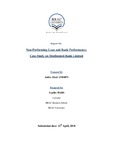| dc.contributor.advisor | Asphia Habib | |
| dc.contributor.author | Afzal, Anika | |
| dc.date.accessioned | 2018-09-25T07:05:55Z | |
| dc.date.available | 2018-09-25T07:05:55Z | |
| dc.date.copyright | 2018 | |
| dc.date.issued | 2018-04 | |
| dc.identifier.other | ID 13104071 | |
| dc.identifier.uri | http://hdl.handle.net/10361/10665 | |
| dc.description | This internship report is submitted in a partial fulfillment of the requirements for the degree of Bachelor of Business Administration, 2018. | en_US |
| dc.description | Cataloged from PDF version of internship report. | |
| dc.description | Includes bibliographical references (page 66-67). | |
| dc.description.abstract | Non-performing Loan or NPL is a very common scenario in our banking industry. Non-Performing loan is a loan which the borrower has missed to pay its scheduled interest payment or payment of the principle amount, generally for at least 90 days or within the mentioned time in loan contract. With the passage of time, the amount of non-performing loan is increasing rather going down. Proper amount of the flow of investment and savings is essential for the economic development of any country. The performance of the financial sector of Bangladesh depends on how the commercial banks are running. As loans are the assets of the banks, non-performing loans becomes liabilities for banks. NPLs don’t earn interests which is income for the banks. NPLs also decrease the loanable funds of the banks which disrupts the cycle of banking business. For every NPL banks need to reserve provision amount to cover its liabilities. These provisions are cut from banks’ profit, which decreases the total profit amount of the banks. For this reason banks face low capital base problem which ultimately have a negative impacts on the overall banking industry. NPL and interest rates are positively related. When NPL increases, the other loans also become more risky. So the rate of interest also increases to cover the risk and get enough return from it. Non-performing loan is a very common phenomenon in Bangladesh banking sector but in recent years the amount of loans being non-performing has increased in an alarming rate. The cause of this rapid growth of non-performing loans can be excessive political interference and misuse of political power of the borrowers. The ratio of the non-performing loans against the total loan amount is 10.7% which is much higher than the international average. The total amount of NPL, according to recent data of Bangladesh Bank, is TK 74,148.54 crore. Bangladesh has 57 banks right now and many other financial institutions, which makes the banking industry very much competitive. To sustain in banking industry, merging and acquisition with another bank can reduce the competition a little, which can be helpful for monitoring the loans properly and reduce the NPL amount. Modhumoti Bank Limited is a new bank, started in 2013. Therefore, the NPL amount of MMBL is very low. Modhumoti Bank Limited does proper documentation before disbursing any loan and also does proper monitoring after giving any loan, which is also one of the cause of low NPL amount. | en_US |
| dc.description.statementofresponsibility | Anika Afzal | |
| dc.format.extent | 70 pages | |
| dc.language.iso | en | en_US |
| dc.publisher | BRAC University | en_US |
| dc.rights | BRAC University internship reports are protected by copyright. They may be viewed from this source for any purpose, but reproduction or distribution in any format is prohibited without written permission. | |
| dc.subject | Banking | en_US |
| dc.subject | Commercial banks | en_US |
| dc.subject | Loan | en_US |
| dc.subject | Modhumoti Bank Limited | en_US |
| dc.title | Non-performing loan and bank performance: case study on Modhumoti Bank Limited | en_US |
| dc.type | Internship report | en_US |
| dc.contributor.department | BRAC Business School, BRAC University | |
| dc.description.degree | B. Business Administration | |

